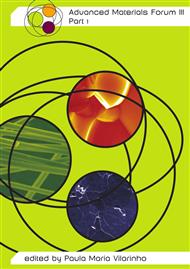p.1328
p.1333
p.1338
p.1343
p.1348
p.1353
p.1358
p.1363
p.1369
Ferroelectric Properties of Pb(Zr,Ti)O3 Thin Film Capacitors Made by RF Magnetron Sputtering and Heat-Treated by the Bottom Electrode Crystallization Method
Abstract:
The bottom electrode crystallization (BEC) method was applied to the crystallization of Pb(Zr,Ti)O3 (PZT) thin films deposited by RF magnetron sputtering on Pt/Ti/SiO2/Si substrates. Using a proportional-integral-differential controller, the current flowing in the Pt/Ti films provided accurately controlled Joule heating for the crystallization of the PZT films. The temperature uniformity of the heat treatments was investigated by measuring the ferroelectric properties of PZT. Platinum and tungsten wires were alternatively used as electrical contacts. Scanning electron microscopy (SEM) images were used to inspect the electrical contact regions between the platinum films and different contact wires. The PZT films showed higher remanent polarizations and lower leakage currents near the electrical contacts when Pt wires were used; the ferroelectric properties were more uniform on the PZT films heat-treated with W contact wires. The BEC method can successfully replace the more conventional means for thin film crystallization, having the advantage of being a very precise, low cost and low power consumption technique.
Info:
Periodical:
Pages:
1348-1352
Citation:
Online since:
May 2006
Authors:
Keywords:
Price:
Сopyright:
© 2006 Trans Tech Publications Ltd. All Rights Reserved
Share:
Citation:


